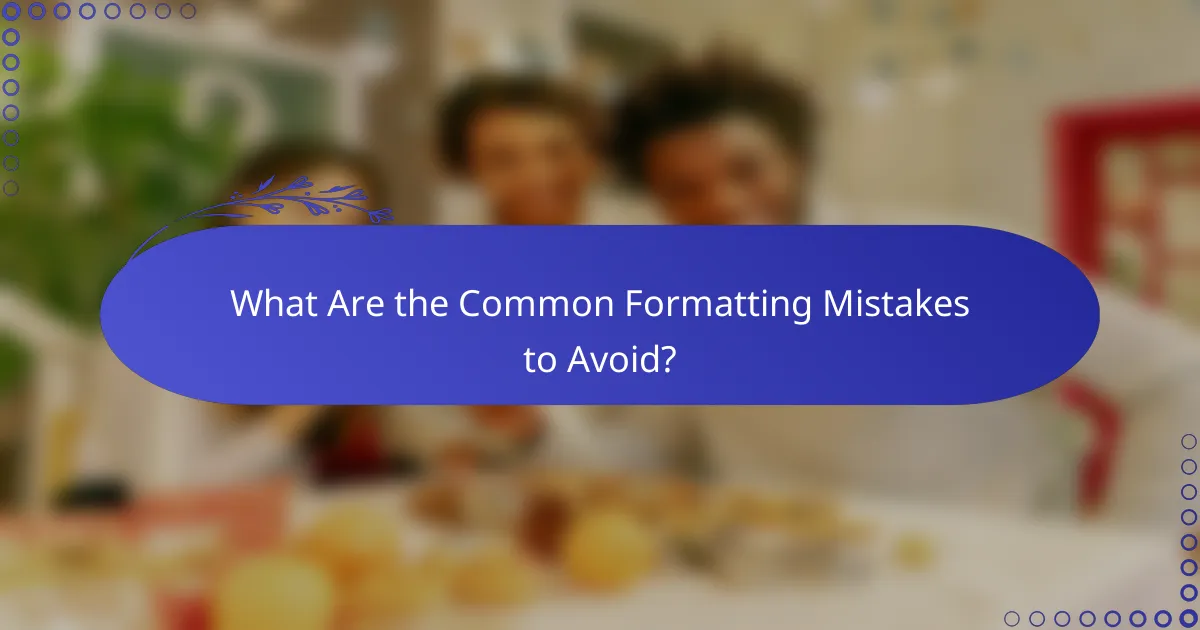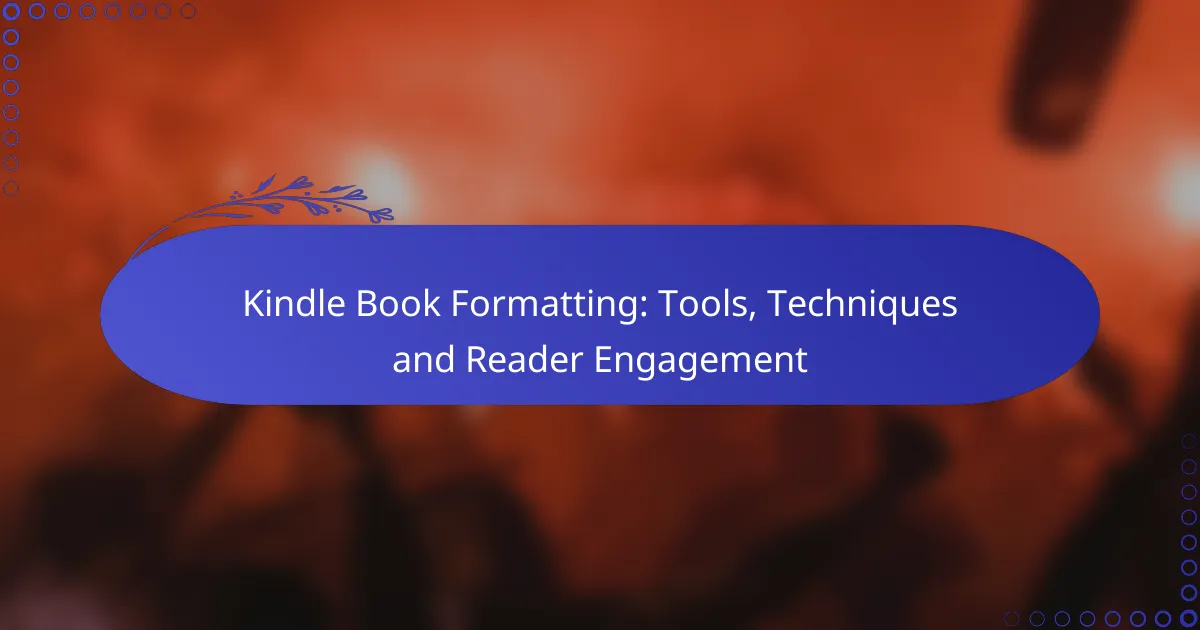Formatting a Kindle book effectively is crucial for ensuring a professional presentation and enhancing reader engagement. Utilizing the right tools can streamline the process, while attention to interactive elements and visual appeal can create a captivating reading experience. By avoiding common formatting mistakes, authors can significantly improve how their work is received across various e-readers.

What Are the Best Tools for Kindle Book Formatting?
The best tools for Kindle book formatting include a range of software designed to streamline the process of preparing manuscripts for e-readers. Each tool offers unique features that cater to different aspects of formatting, from manuscript preparation to professional layouts.
Scrivener for Manuscript Preparation
Scrivener is a powerful writing tool that helps authors organize their manuscripts effectively. It allows you to break your work into manageable sections, making it easier to structure your book and keep track of your progress.
When using Scrivener, take advantage of its corkboard and outline features to visualize your content. This can help you maintain coherence and flow throughout your book, which is crucial for reader engagement.
Calibre for E-book Conversion
Calibre is a versatile e-book management tool that excels in converting various file formats into Kindle-compatible formats. It supports a wide range of e-book formats, making it a go-to choice for authors looking to publish across multiple platforms.
To use Calibre effectively, import your manuscript and select the desired output format, such as MOBI or AZW3. Be mindful of the conversion settings to ensure your formatting remains intact, as improper settings can lead to layout issues.
Vellum for Professional Formatting
Vellum is renowned for its user-friendly interface and high-quality formatting options, making it ideal for authors seeking a polished final product. It offers a variety of templates that can be customized to fit your book’s genre and style.
With Vellum, you can easily create print and e-book versions of your manuscript. However, it is only available for macOS, so Windows users may need to consider alternatives or use a virtual machine.
Kindle Create for Amazon Integration
Kindle Create is Amazon’s official tool for formatting e-books specifically for Kindle devices. It simplifies the process by providing templates that adhere to Amazon’s guidelines, ensuring your book meets their standards.
Using Kindle Create, you can import your manuscript and apply formatting styles with just a few clicks. This tool is particularly useful for authors who plan to publish exclusively on Amazon, as it streamlines the submission process.
Adobe InDesign for Advanced Layouts
Adobe InDesign is a professional desktop publishing software that offers advanced layout capabilities for e-books. It is ideal for authors who want complete control over their book’s design, including typography and graphics.
While InDesign provides extensive customization options, it has a steeper learning curve compared to other tools. Consider investing time in tutorials to maximize its potential, especially if your book requires intricate layouts or design elements.

How to Format a Kindle Book for Maximum Reader Engagement?
To format a Kindle book for maximum reader engagement, focus on creating an interactive and visually appealing reading experience. This involves using interactive elements, optimizing font choices, and implementing visual breaks to maintain reader interest and enhance comprehension.
Using Interactive Elements
Incorporating interactive elements in your Kindle book can significantly boost reader engagement. Features like hyperlinks, embedded videos, and interactive quizzes allow readers to explore additional content and deepen their understanding of the material.
Consider using hyperlinks to direct readers to relevant resources or related chapters. Ensure that these links are functional and lead to high-quality content, as broken links can frustrate readers and detract from their experience.
Optimizing Font Choices
Selecting the right fonts is crucial for readability and overall engagement. Use fonts that are easy to read on digital screens, such as Georgia or Arial, and maintain a font size between 11 and 14 points for body text.
Avoid using too many different fonts in one book; stick to one or two for consistency. Additionally, ensure that your font choices align with the genre of your book, as a playful font may not suit a serious non-fiction title.
Implementing Visual Breaks
Visual breaks help prevent reader fatigue and enhance comprehension. Use chapter breaks, images, and white space strategically to create a more inviting layout. Aim for a balance between text and visuals to keep readers engaged without overwhelming them.
Consider adding images or infographics that complement your text. Ensure these visuals are high quality and relevant, as they can help illustrate complex ideas and maintain reader interest throughout the book.

What Are the Common Formatting Mistakes to Avoid?
Common formatting mistakes in Kindle book publishing can significantly impact reader experience and engagement. Avoiding these pitfalls ensures your book looks professional and is easy to read on various devices.
Ignoring Kindle Previewer
Using the Kindle Previewer is essential for checking how your book appears on different devices. This tool allows you to see formatting issues that may not be apparent in your editing software. Always test your book in both portrait and landscape modes to ensure a seamless reading experience.
Common issues to look for include misaligned text, incorrect image sizes, and broken links. Regularly using the Previewer can save you from negative reviews related to formatting errors.
Overlooking Metadata Importance
Metadata plays a crucial role in how your book is discovered and categorized on Kindle. This includes the title, author name, keywords, and book description. Properly optimizing your metadata can enhance visibility and attract the right audience.
Ensure that your keywords are relevant and specific to your genre. A well-crafted book description should be engaging and informative, ideally between 150-300 words, to entice potential readers.
Neglecting Consistent Styles
Maintaining consistent styles throughout your book is vital for a polished look. This includes font choices, heading sizes, and paragraph spacing. Inconsistent formatting can distract readers and detract from your content.
Establish a style guide before formatting your book. For instance, use the same font size for body text and headings, and ensure that bullet points and lists are formatted uniformly. This attention to detail can greatly enhance readability and professionalism.

What Are the Key Formatting Techniques for Kindle Books?
Key formatting techniques for Kindle books include using proper headings, incorporating hyperlinks, and managing page breaks effectively. These elements enhance readability and engagement, ensuring that your content is accessible and appealing to readers.
Utilizing Proper Headings and Subheadings
Proper headings and subheadings are essential for organizing content in Kindle books. They help readers navigate through sections easily and improve the overall structure of the text. Use a clear hierarchy, starting with H1 for the title, followed by H2 for main sections, and H3 for subsections.
When formatting, ensure that each heading is descriptive and relevant to the content that follows. This not only aids in comprehension but also enhances the book’s searchability on platforms like Amazon. Avoid excessive styling; simplicity often leads to better readability.
Incorporating Hyperlinks Effectively
Effective use of hyperlinks can significantly enhance the reader’s experience in Kindle books. Links should direct readers to relevant resources, such as additional content, references, or related topics. Ensure that hyperlinks are clearly visible and functional, ideally using a contrasting color.
Limit the number of hyperlinks to maintain focus and avoid overwhelming the reader. A good practice is to include links at the end of chapters or sections, allowing readers to explore further without disrupting their reading flow.
Managing Page Breaks and Chapter Layouts
Managing page breaks and chapter layouts is crucial for a seamless reading experience. Use page breaks to separate chapters and sections clearly, preventing content from running together. This helps maintain the narrative flow and keeps readers engaged.
Consider the typical length of chapters in your genre; most Kindle books feature chapters that range from 1,500 to 5,000 words. Consistent chapter layouts, including titles and numbering, also contribute to a professional appearance and help readers track their progress.

What Are the Prerequisites for Successful Kindle Formatting?
Successful Kindle formatting requires a solid understanding of digital file types and adherence to e-book standards. Familiarity with these elements ensures that your book is compatible with Kindle devices and provides a seamless reading experience.
Understanding Kindle File Types
Kindle books primarily use the MOBI and AZW file formats, which are optimized for Amazon’s Kindle devices. These formats support features like reflowable text, which adjusts to different screen sizes, enhancing readability.
When preparing your manuscript, consider converting your document into these formats using tools such as Kindle Create or Calibre. This step is crucial, as it ensures your book retains its formatting and layout across various devices.
Familiarity with E-book Standards
Adhering to e-book standards, such as EPUB and HTML5, is essential for successful Kindle formatting. While Kindle devices support MOBI and AZW, understanding EPUB can help you create a more polished product that can be easily converted.
Pay attention to aspects like metadata, cover design, and table of contents, as these elements significantly impact reader engagement. Using proper formatting techniques can prevent common pitfalls, such as broken links or misaligned text, which can frustrate readers.
